THINGS TO DO


Ten ways to enjoy the shimmering sea p. 24

MEET THE LOCALS
Meet Malta’s leading mezzo soprano p. 42
FASHION
Local design duo’s fascinating collection p. 66

EXPERIENCE MALTA & GOZO SUMMER/AUTUMN 2023 | € 7.50 GUIDEMEMALTA.COM


















Mosta Church during Santa Marija feast.

Photo: Josef Awad
CONTENTS
24.
38. 24
Ten ways to enjoy the sea: from scuba diving to beach clubbing

There are countless ways to enjoy the islands’ crystal-clear waters, whether you’re an adrenaline junkie or simply a sun worshipper, or your preferences lie somewhere in between. Esther Lafferty entices you to have fun in and on the water.
Beach bliss: the islands’ secluded swimming spots
Want to get away from the crowds, yet enjoy a patch of soft sand and cool waters? Guide Me Malta lets you in on the islands’ lesser-known beaches, which are great for a swim in the warmer months and a walk-around in the colder ones.

A season of revival
The Maltese mezzo soprano’s debut at London’s Royal Opera House
Marvic Monreal is set to become the first Maltese mezzo soprano to debut at London’s prestigious Royal Opera House. Rebecca Anastasi catches up with her ahead of her performance to discuss her journey and what’s in store.
020
32.
42.
Adrian Mamo, the Artistic Director of Malta’s national theatre, Teatru Manoel, tells Dean Muscat all about the forthcoming season audiences can look forward to. 51 74
Photo: Maurizio Modena - viewingmalta.com
Photo: viewingmalta.com
51.
Heralding in the season of the lampuka
At this time of year, most restaurants will likely feature lampuki on their menu or daily specials boards. Sarah Muscat Azzopardi finds out about this celebrated fish, that has been a staple on local tables for generations, and how best to enjoy it during your stay.
59.
Investing in Malta guide
An in-depth look at what it takes to set up a business in Malta, the new and emerging economic sectors attracting local and international investment, and why the islands are considered a business and financial services hub in Europe.
66.
ON THE COVER
Location: Comino
Photography: Andrey Danilovich - iStock
PUBLISHERS
Content House Group
ADVERTISING
Brand Sales Manager
Wanaha Camilleri
Operations & Client Relationship Manager
Sue Ann Pisani
Client Relationship & Administration Executive
Shana Tabone
ART DIRECTION & DESIGN
Nicholas Cutajar
When architecture and fashion collide
Local design duo Samaria and Vincienne Bezzina, the siblings behind Maltese fashion brand BAJJA, have recently showcased a wonderful collection, artistically combining fashion with architecture, in a project in collaboration with Malta’s Planning Authority. Sarah Muscat Azzopardi meets the pair to find out more.
Malta unveiled: unmissable experiences on the islands
Rebecca Anastasi offers an insiders’ round-up of the must-dos and must-sees during your stay. She meets four cultural experts who share their advice on what to experience this season.
EDITORIAL CONTRIBUTORS
Rebecca Anastasi, Esther Lafferty, Dean Muscat, Sarah Muscat Azzopardi
Content House Group, Mallia Buildings, 3, Level 2, Triq in-Negozju, Zone 3, Central Business District
Birkirkara CBD 3010
T: +356 2132 0713
E: info@contenthouse.com.mt
W: www.contenthouse.com.mt
Published since 2005, Guide Me is the largest and the leading independent guide for visitors in Malta and Gozo. This issue covers the Summer/Autumn 2023 period. Guide Me is distributed free of charge through leading hotels around Malta and Gozo. The publication is also distributed for free from MTA offices in Malta and Gozo. It is also sold at leading newsagents in Malta and Gozo, including those at the MIA and the Gozo Channel ferries.

Editorial opinions expressed in Guide Me are not necessarily those of Content House Group and the company does not accept responsibility for advertising content.
All rights reserved. Reproduction in whole or in part without written permission of the publishers is strictly prohibited.
021
74.

BEACHES, CULTURE, FOOD AND MORE
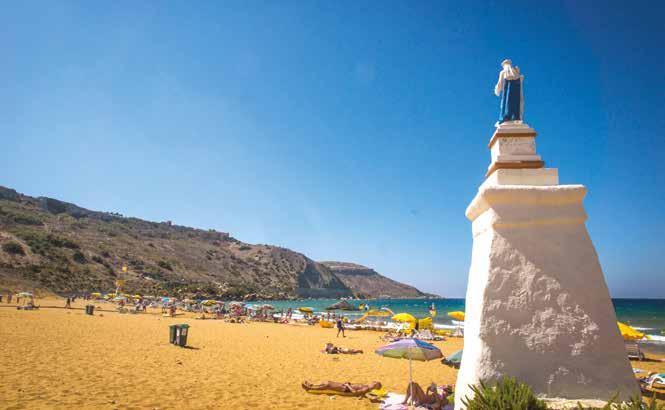
Welcome to the Maltese islands – an archipelago that fuses modernity with a rich cultural heritage. On arrival, you might be lost on how to make the most of your stay, so we’ve put together a diverse mix of articles that touch upon a variety of topics to help you navigate your way around and to capture the essence of what these Mediterranean isles have to offer.
Whether you’re visiting in the scorching hot months or in the cooler shoulder ones, you can’t avoid the shimmering waters that lap the islands’ shore. In our first article, Esther Lafferty lists the top ten things to do to enjoy the sea – from scuba diving to beach clubbing, and yacht chartering to wind surfing. And if the crowds get to you, why not head to a secluded beach? In our Explore article, we’ve rounded up some of the lesser-known beaches, to let you in on the spots that, although are sometimes hard to reach, will reward you with utter bliss. You can either dive right in or hike around the coastline for unforgettable views.
At this time of year, fishermen are busy catching the locals’ favourite fish – the lampuka, also known as dolphin fish, or dorado or mahi-mahi. There are multiple ways of serving this popular fish, which has
been a staple on local tables for generations, and which is still caught in the traditional way. Turn to the Food and Drink section on page 51 to find out how it’s caught and how it’s cooked and served.
If it’s art and culture you’re after, you will not be disappointed. In the Art & Culture section, Rebecca Anastasi speaks to four local cultural experts to reveal what they’re looking forward to this season. They offer a mix of recommendations, from theatrical performances to musical events, and from art exhibitions to local feasts. And on the subject of music, in this issue, we feature an interview with a talented Maltese mezzo soprano, Marvic Monreal, who is about to debut at London’s Royal Opera House. She lets us in on what has led to this remarkable achievement and what’s in store in the months to come.
In another engaging interview, we meet design duo –and siblings – Samaria and Vincienne Bezzina. As part of an original collaboration with the local Planning Authority, they have sought inspiration from four iconic buildings in Malta to create a wonderful collection of designs. Turn to page 66 to view their “wearable works of art”.
We hope you enjoy this edition of Guide Me.
023
EDITORIAL
Ramla Bay, Gozo.
Photo: viewingmalta.com
TEN WAYS TO ENJOY THE SEA: FROM SCUBA DIVING TO BEACH CLUBBING

024 THINGS TO DO
Wied il-Għasri, Gozo. Photo: viewingmalta.com
1.
Malta’s famed for the crystal-clear seas that lap along its shoreline in enticing shades of topaz blue and tropical turquoise. It’s a great place to enjoy surfing, standup paddle boarding, snorkelling, and more. ESTHER LAFFERTY explores some great ways to have fun in and on the water.

SWIMMING: AN AGE-OLD PLEASURE
In late summer, the water is at its warmest: temperatures top 25°C degrees. It’s simply glorious to step in from bright sunshine and be refreshed whether that’s from a sandy beach, via a swim ladder or with a big splash from a diving platform or low cliff. For a dip for all the family, you’ll have peace of mind at Blue Flag beaches which have marked swimming areas and lifeguards: try St George’s Bay in St Julian’s, the gorgeous Golden Bay or, over in Gozo, Ramla Bay or Ħondoq ir-Rummien for both a beach experience and great jumping. For something a little different, head to Qawra point, close to the National Aquarium, for the circular sea pool, or Gozo’s Wied il-Għasri ‘fjord’, a sparkling tongue of water along which experienced swimmers can reach open seas beneath high cliffs.
2.
SNORKELLING: A WINDOW INTO THE WONDERS BELOW
Where Malta meets the sea, with simply a mask and snorkel, you can explore an underwater world of rocks and reefs, caves and corals in which shoals of fish flash silver, orange, blue, and yellow. The island’s smaller inlets and coves are often the best spots for interesting topography and marine life.
Għar Lapsi, a tiny fishing spot near Siġġiewi, is a top destination, with shallow rock beds and several nooks and crannies packed with diverse fish species, while the remote cove of Fomm ir-Riħ is another hidden treasure. In Gozo, the Coral Gardens by Dwejra’s Inland Sea are a great place to start and, for stronger swimmers, beneath the salt pans between Marsalforn Bay and Qbajjar, you’ll find a marvellous underwater moonscape riddled with craters and pockets of life. Look out for flat flounders camouflaged on white sand, parrotfish, rainbow wrasse, and even flying fish, starfish, and octopus too.
025
Photo: viewingmalta.com

WINDSURFING: RIDE THE WAVES

Windsurfing combines the excitement of surfing with the elegance of sailing as you harness the power of the wind to ride the waves. You’ll find windsurfing available on many of Malta’s sandy beaches including the glorious Golden Bay. Although the coastline that runs from Mellieħa to Qalet Marku is the island’s top windsurfing stretch, you can enjoy a taster session (approx. €45) or take a short course to get all the basics under your belt in places from Paradise Bay to Marsascala. The wide flat waters of Mellieħa Bay are brilliant for both newcomers to the sport and those who want to head out for speed and slalom, whilst south of Salina Bay, adjacent to St Paul’s, the stretch of water between Għadira s-Safra Nature Reserve and Għallis Rocks 200m offshore is a cracking spot for the experienced windsurfer, especially in a north-westerly wind.
3.
SCUBA DIVING: EXPLORE THE UNDERWATER WORLD
Beneath the surface of Malta’s azure seas, there’s extraordinary visibility and a wealth of wonders to discover. It’s a giant underwater playground for divers of all abilities, and with dozens of dive centres across Malta and Gozo, it’s easy for the uninitiated to have a try. There are stunning rock landscapes with big boulders, arches and pinnacles to explore, as well as the iconic Blue Hole (an underwater rock chimney), and a peacock-blue ‘Z for Zorro’ swim-through in Comino’s Santa Marija caves. Keep your eyes peeled for lionfish, shoals of barracuda, solitary seahorses, rays and moray eels. There are also dozens of fascinating wreck dives at depths ranging from 16m – HMS Maori, a British destroyer in Valletta’s Grand Harbour – to 115m. The wrecks include a 10,000 tonne oil tanker, the submarine HMS Stubborn and a four-engine B-24 Liberator heavy bomber, part of Malta’s World War II heritage. Typically a guided shore dive costs around €50 and a ten-dive package will cost €300-€400. Some equipment may need to be hired separately.

027 THINGS TO DO
4.
Mġarr ix-Xini.Photo:PeteBullen -viewingmalta. com
Photo: Markus Kirchgessner - viewingmalta.com
SAILING AND YACHT CHARTERING: HOP ON A BOAT
The Maltese islands are brilliant for boating as they often enjoy both glorious sunshine and, for sailing, a steady wind: if you fancy taking to the waves, there’s a wealth of options from small dinghies in Għadira Bay (at €60 for 2 hours) to relaxing tours on a catamaran (5 hours, from €40 per head). And when you explore the Maltese islands by sea, you really appreciate their vast history when ancient traders, knights and pirates arrived on these shores at the very heart of the Mediterranean by boat. From the water, you’re also best-placed to marvel at the towering cliffs, giant arches, hidden caves, and secluded coves.

If you’re a sailor with an eye for the breeze and you’d like to rent a boat to circumnavigate the islands by sail, then the marinas in Valletta, The Three Cities, Ta’ Xbiex and Sliema are good places to start. Prices range from €500 to €800 for day hire, depending on the yacht size.
Alternatively, charter a private yacht complete with a friendly skipper for a hassle-free day out on the water enjoying the beauty of the islands and their beaches, and the chance to swim and snorkel in a secluded spot. Island Life Charters, for example, have several yachts of different sizes – whether for a romantic cruise for two or a family of ten, operating from Mellieħa Bay and Mġarr, Gozo, whilst family-run Leomaris Charters offer great half- and full-day options for groups of up to 20 on the Princess 415 ‘Mirador’ as well as a sunset dinner cruise for the ultimate luxury experience for your friends and family.
JET-SKIING AND POWER BOATS: FAST, FURIOUS FUN
Malta’s sheltered bays are perfect places to make waves on a high-speed jet ski, a powerful and playful watercraft for thrill-seekers. You’ll feel as if you’re flying as you skim across the water taking tight turns and twisting the throttle to accelerate and get your adrenaline flowing. You can rent a craft to have a go individually or as a pair for approx. €50-€70 for a speedy 30 minutes. Alternatively opt for a one-to-two-hour Jet-ski Safari tour from St Thomas Bay encompassing St Peter’s Pool, Delimara Bay with its clifftop fort and the beautiful caves of Blue Grotto, or head towards Gozo from Popeye’s Village to explore Comino’s Crystal and Blue Lagoons. Prices range from €165 to €400 per two-person jet ski.
You can also hire smaller self-drive boats for your friends and family but for the fastest ride on the Maltese islands, then take a trip with Supreme Powerboats whose iconic red boats whip across the waves powered by Yamaha 300hp engines and skippered by experienced handlers. You can opt for a tour to Comino’s caves, or go for thrills with exciting turns and figure-of-eights.
7.
WATERSKIING: SKIM THE WAVES AT SPEED
If you’d like to pit your strength, coordination and balance against the water, then waterskiing is just the ticket. Lean back as the tow boat moves forward and skim behind it at speeds between 25 and 50kmph. Depending upon your experience you can glide, plane, jump, and perform stunts: the faster you go the more tricks you can do! If you’re a newbie, then Malta’s a great place to get started, at approx. €50 per 30 minutes, and Little Armier Bay on the Marfa Ridge, facing the smaller islands of Comino and Gozo, is a magic spot for this. Mind you, if you’d rather sit for your thrills, then you can always opt for a go on a banana boat instead.
THINGS TO DO 028
Comino. Photo: Francisco - stock.abode.com
6.
5.


9.
8.
KAYAKING: A PADDLE-PROPELLED ADVENTURE

If you prefer to be self-propelled, then there’s sea kayaking for all levels of energy and expertise. You can even hire clear kayaks, which can be delivered to any of Malta’s bays, from which you can see the underwater world beneath you as you paddle (€20 for 1st hour, after which they’re €10 per hour). Also available from many spots in Malta and Gozo, sea kayaking tours combine activity and tranquillity so that as you explore the rugged coastal beauty that wraps the land you earn your end of the day gin and tonic. Over in Gozo, you can set off from the famous Inland Sea heading through a ‘secret’ tunnel in the rock to open water, or from Ħondoq, it’s only a 20-minute kayak across the channel to Comino where, as well as the popular Blue Lagoon, there are impressive rock arches, hidden caves and beautiful, quiet bays to discover.
PARASAILING: THE BIRD’S EYE VIEW

To enjoy the water from above, consider trying your hand at parasailing – flying up to 200m over the sea beneath a colourful parasail wing towed by a boat below. Often considered an extreme holiday activity, there’s a great adrenaline rush on take-off and, afterwards, an extraordinary sensation of peace and quiet as you float high in the sky. For around €40, the beautiful vistas of Malta’s cliffs and bays are laid out in front of you as you glide through the air, and it’s a memorable way to enjoy all the action below, scattered on a palette of blues. From Sliema, get a bird’s eye view across to historic Valletta, from St George’s Bay see an entirely different perspective on party-town Paceville, or from Mellieħa look across to Comino and Gozo.
10.
BEACH CLUBBING: IT’S PARTY TIME
The Mediterranean equivalent of aprèsski is the beach-clubbing event, a lively fusion of vibrant beach vibes and clubbing culture. After a relaxing afternoon chatting and chilling on a luxurious lounger at the beachfront bar, sipping cocktails under the sun, party at the water’s edge while DJ beats provide a backdrop for your sea view, drinks and dancing. Reserve a sunbed for €20€35 or opt for a luxury gazebo for a small group for around €150, and settle in for the duration.
In St Paul’s Bay, St Julian’s and Sliema you’ll find fine beach clubs renowned for popular pool parties and spectacular sunsets, fine dining, crisp linen and cool pool lidos before their evening transformation into pumping nights. Further from the beaten track, beach clubs in spots on wilder beaches (along the Marfa Ridge, for example) have a relaxed rustic vibe for rural days before they too step up the beat with pulsating evening parties at the edge of the sea.
THINGS TO DO
Photo: Markus Kirchgessnerviewingmalta.com
031
Photo: viewingmalta.com
BEACH BLISS: THE ISLANDS’ SECLUDED SWIMMING SPOTS
There’s no denying Malta gets very busy during the warmer months –but that doesn’t mean you can’t find a patch of sand to call your own. GUIDE ME MALTA hunts down Malta’s lesser-known beaches.

EXPLORE
032
Kalanka Bay. Photo: viewingmalta.com
Just picture it: you, your towel and a stretch of sand all to yourself… It’s what Mediterranean island dreams are made of.
OK – now we have to admit that that’s not exactly the image associated with most Maltese beaches. After all, the long, lazy days of summer are also very busy, with hundreds of thousands of visitors and locals pouring onto the islands’ largest beaches to enjoy the sun, sea and facilities (most of these bays have cafés, restaurants, showers, toilets, water sports, and more).
But if that doesn’t float your boat, then don’t worry, because we’ve put together a list of some of the islands’ lesser-known swimming spots. And we promise – that while they won’t quite be ‘deserted’ – they won’t be anywhere near as busy, and they will be absolutely stunning.
FOMM IR-RIĦ
From Rabat, follow the signs to Baħrija
If you enjoy snorkelling, then this is the beach for you – although it will take quite a trek to get you here. Fomm ir-Riħ is considered one of the most isolated beaches on the island, but it’s also the one we think is most worth the effort (especially as most people are unlikely to have done so themselves). Aside from the remoteness of this bay and its tranquillity, we love the fantastic views of the cliffs, valleys and the sea. To get here, allow at least 20 minutes for the walk down the steep pathway (and bear in mind you’ll have to climb it back up). Do also consider that it can get very choppy when the winds blow from the north or northwest, so swimming in these conditions is not recommended.
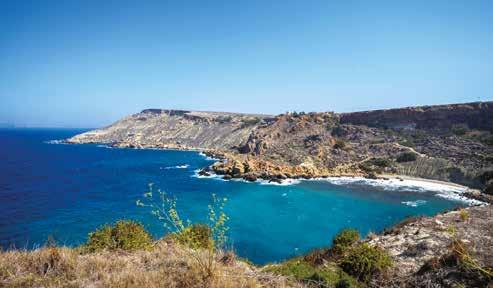

033
Fomm Ir-Riħ. Photo: Jürgen Scicluna - viewingmalta.com
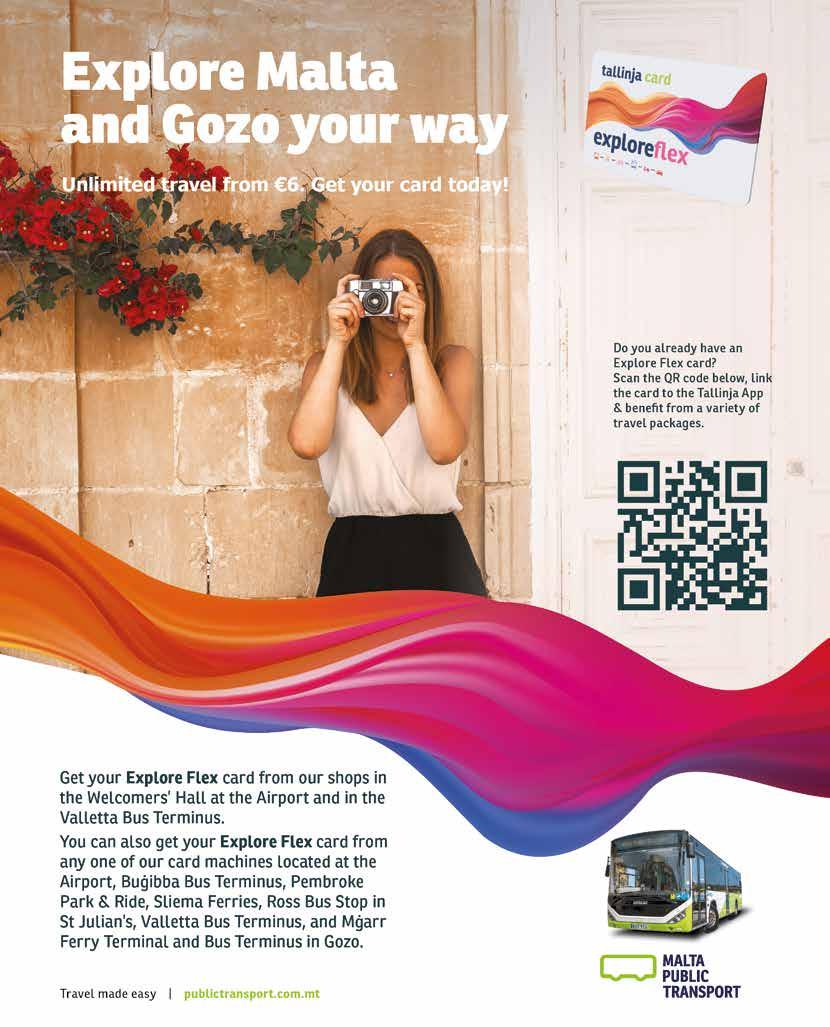
SELMUN BAY (IMGIEBAH BAY)
Best reached from Selmun Palace Selmun Bay, also known as Imgiebah Bay, is a secluded, dogfriendly beach that’s tucked away on the northern coast of Malta. This hidden gem boasts crystal-clear waters and golden sand, and is perfect for sunbathing and swimming. The beach is a little off the beaten path, and is only accessible on foot or by boat, providing a serene escape from other bustling tourist spots. The area also offers several scenic hiking trails that wind through breath-taking landscapes and provide stunning vistas.
KALANKA BAY
From Marsaxlokk, head to Delimara


Known as a natural swimming pool, this rocky beach is well off the traditional tourist track and likely to be quiet even at the height of summer. The bay sits within the curves of limestone rock that surround it and the sea is perfect for swimming and snorkelling. Just bear in mind that there are no lifeguards on duty and no facilities anywhere nearby, so go prepared with food and drink –and plenty of sun cream too, as there is little shade around here.
PETER’S POOL
From Delimara, take the road to the lighthouse and follow the signs
This is another natural pool, and another great place to dive in and enjoy the crystal-clear waters. This spot is better known and can get a little busier, however it’s worth the trip as the deep waters and striking limestone rocks make for a fabulous combination. Plus, if the sea is calm, then the waters go an unusual, blue-green colour, which makes them all-themore spectacular.

WIED IL-GĦASRI, GOZO
Access Wied il-Għasri from Għasri village square or Marsalforn
Again, this is more of a spot for swimmers or snorkellers than sunbathers, but it is absolutely beautiful. This narrow creek is known for its underwater caves, including the much-talked about Cathedral Cave. Highlights include the views of the high cliffs on either side and the clean waters, as well as the little pebbly beach (although you will probably need to get here early if you want a spot on it).
EXPLORE
035
Selmun Bay (Imgiebah Bay) Photo: viewingmalta.com
Peter’s Pool. Photo: viewingmalta.com
Wied il-Għasri, Gozo. Photo: viewingmalta.com
SAN BLAS BAY, GOZO
Drive to Nadur, then follow the signs to San Blas Gozo’s best-known beach is Ramla l-Ħamra, a long stretch of sand that’s famous for its reddish hue. San Blas Bay may not be quite as grand – or have any of the handy facilities like the beach cafés and sunbed rentals – but it is just as pretty, and far more secluded. The downside? Well, you will have to trek down (and then up) a steep hill to get here, but we think it’s worth it – especially as the sand is gorgeous and the waters super clean. This is also a great spot for a picnic – just remember to pack any litter away before you go!
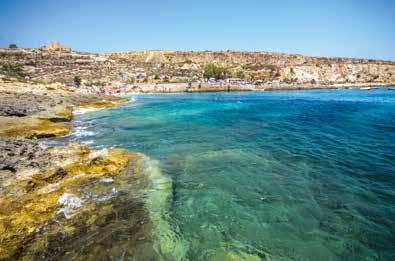

ĦONDOQ IR-RUMMIEN, GOZO
Reached through the village of Qala
A small, well-loved, beach, just beyond the village of Qala in Gozo, Ħondoq ir-Rummien (which can be translated into the poetic Pomegranate Moat in English) is a pebbly beach, whose waters are crystalline. The bay is popular with divers and snorkelling enthusiasts, due to its caves at water
level, and its snack bar will ensure you’re not left wanting, but it can all get quite busy during the summer months. The sea can be accessed by ladder from the rocks, and you can always follow your dip with a walk through the Gozitan countryside to the salt pans on the same coastline.
SANTA MARIJA BAY, COMINO

Once on Comino, follow the road up from the Blue Lagoon
If you’ve found yourself on beautiful Comino but you can’t find a spot to sit, then opt out of the Blue Lagoon and, instead, walk over to Santa Marija Bay. Located on the other side of this tiny island, this bay may not be quite as striking as its famous relative, but it is definitely more tranquil. We love the shallow waters, which are ideal for paddling, while the sandy beach is a good space to relax.
EXPLORE
San Blas Bay, Gozo. Photo: viewingmalta.com
Ħondoq Ir-Rummien, Gozo. Photo: Jürgen Scicluna - viewingmalta.com
Santa Marija Bay, Comino. Photo: viewingmalta.com
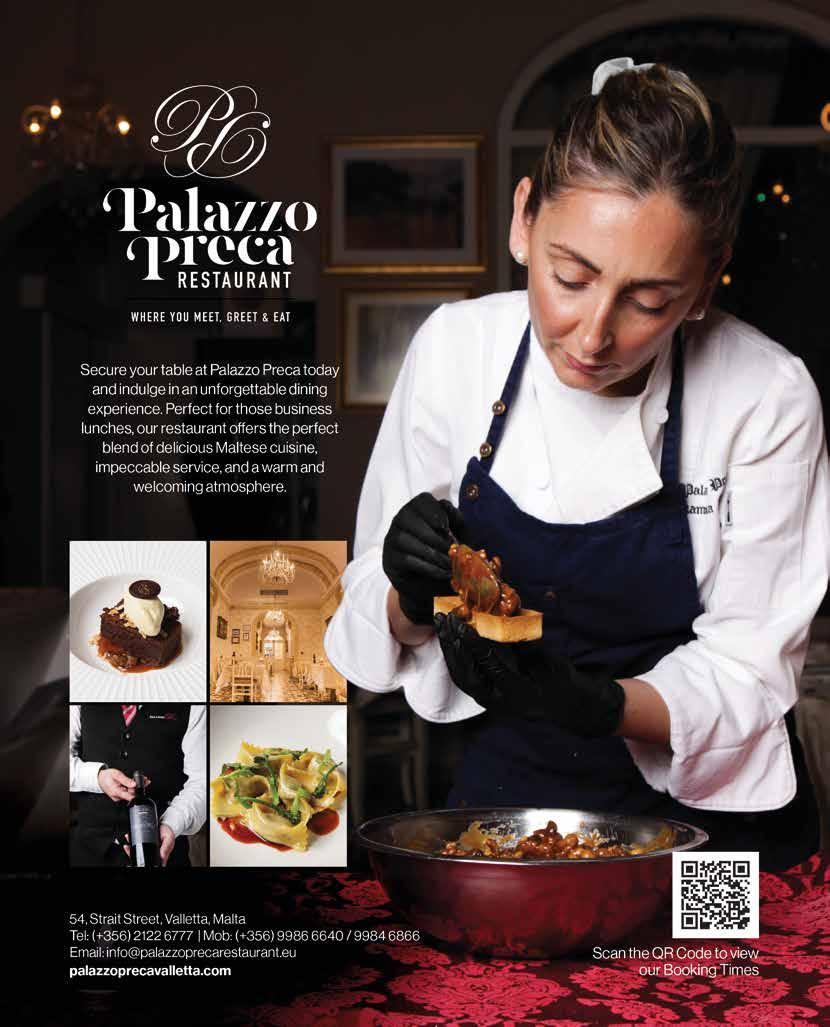
A SEASON OF REVIVAL
Embarking on a new chapter in its 300-year history, Teatru Manoel is set to take centre stage once again. Speaking to DEAN MUSCAT, Artistic Director ADRIAN MAMO delves into the timeless significance of the national theatre and its duty to provide artistic excellence, and offers a glimpse into the forthcoming season that awaits audiences.
In a world where streaming services, endless online entertainment, and now, even instant AI-generated art dominate our screens, the traditional theatre may seem like a relic of the past. However, for Adrian Mamo, the newly appointed Artistic Director of Teatru Manoel, the islands’ national theatre, the value and significance of theatre in our society remain resolute.
Since assuming the role in April of this year, Adrian has found himself reflecting on the theatre’s historical roots to better understand the role it needs to assume today. “The theatre is an important place,” he shares, “because it allows us, as human beings, to do what we do best: immerse ourselves in imagined worlds through the art of storytelling. This is a tradition that goes back to the ancient Greeks, who used theatre as a platform for discussing profound themes such

038
CULTURE
Photo: Brian Grech
as power, morality and societal issues. It has always been a source of education and enlightenment, provoking thought and dialogue among communities.”
People are certainly not in lack of entertainment nowadays, but Adrian questions the narratives we increasingly consume and their impact on our growth as individuals and as a society: “what quality of stories are we receiving? Do they have substance? I believe that it is our responsibility, within the theatre, to be a beacon of quality and substance. It is our duty to bring people together to experience live performances that aspire to uplift, inspire and transform.”
A highly accomplished architect by profession, Adrian has long harboured a love for the arts from a very young age, particularly in the realm of theatre and music. Moonlighting as a set designer for many years, he has created sets for more than 50 local productions, 25 of which were staged at Teatru Manoel alone.
His first foray into set design brought him face-to-face with the challenge of creating a moving set for a local production of Chekhov’s timeless masterpiece, ‘The Cherry Orchard’ at the Manoel. Reflecting on that formative experience, he reveals: “I was intrigued by how you could create a whole world on such a small stage.”
Now taking on the role as Artistic Director for the theatre he has dressed up countless times, Adrian explains his responsibilities extend far beyond merely setting a vision and curating a programme of events every season. For him, it is imperative to challenge the artists and theatre-makers who bring their productions to the Manoel’s illustrious stage in order to push the boundaries of artistic expression, elevate the quality of the craft and urge them to give the very best in every aspect of their work. This ranges from the selection of
productions to the meticulous design of sets and the curation of exceptional talent.

“I also feel it is my duty to be a scout of sorts, staying attuned to the live theatre scene across Malta,” he adds. “I make it a point to actively seek out promising productions and up-and-coming talent. When a production truly captures our attention and showcases genuine artistry, I am eager to provide these hidden gems with the recognition and exposure they deserve on the Manoel stage.”
In the spirit of opening the doors of Teatru Manoel to new voices, fresh perspectives and untapped talent, Adrian is also actively championing new writing, seeking to create a platform where contemporary and relevant works can thrive. Recently, Teatru Manoel in collaboration with Teatru Malta – the national theatre company –issued a call for new theatre works. This initiative serves as an exciting research and development programme, nurturing budding playwrights.
“We are especially keen to find works that feel contemporary and relevant to the world we live in today. When works of outstanding quality emerge from this creative exploration, we are determined to

039
bring them to the stage at Teatru Manoel and breathe new life into our theatre scene,” he states.
As the theatre forges ahead with these dynamic, longterm plans, constantly evolving to shape its future, Teatru Manoel also eagerly anticipates the arrival of its forthcoming artistic season. Spanning from September to June, the programme promises an exhilarating line-up of productions that cater to diverse tastes and artistic preferences, including plays in both Maltese and English, dance shows, musicals, puppet performances, and more.
Several highly anticipated annual highlights are poised to make a triumphant return. Among these is the Christmas pantomime, a much-loved Manoel tradition. This year, audiences can anticipate a spell-binding rendition of ‘Beauty and the Beast’, brought to life by the exceptional talent of the Malta Amateur Dramatic Club.
In January, the theatre will undergo a transformation as the Valletta Baroque Festival takes centre stage. And as spring blossoms, the stage will become a canvas for leading classical and contemporary ensembles and virtuosos during the Malta Spring Festival.
What’s more, two extraordinary opera productions are set to offer audiences an immersive journey into the arena of heart-rending arias, larger-than-life storytelling and spectacular set design. Recognising the theatre’s unique suitability for smaller operas, the Manoel team aims to showcase lesser-known masterpieces by celebrated composers that will enchant local audiences with their musical prowess and breath-taking theatricality.
On 10th and 11th November, the stage will come alive with Mozart’s enchanting ‘Apollo et Hyacinthus’. Written by the musical prodigy at the tender age of 11, this early masterpiece delves into the Greek myth of Hyacinth and Apollo as narrated by the renowned Roman poet Ovid in his ‘Metamorphoses’. Produced by Festivals Malta, this production presents a special occasion for opera enthusiasts to enjoy the live experience of this exquisite opera on local shores.
In early March 2024, the theatre will proudly present its own production of the lesser-known opera ‘Armida’ by Italian composer Gioachino Rossini. Blending mythology and history, ‘Armida’ tells a fantastical tale set during the Crusades, where a sorceress blessed with beauty and dark powers, seeks to regain the love of the noble knight Rinaldo.

Accompanied by the Malta Philharmonic Orchestra, under the baton of esteemed Italian conductor Davide Levi, this visually stunning rendition boasts the creative vision of stage director Paul Carr. The principal tenor roles will be performed by Malta’s very own Three Tenors: Alan Sciberras, Cliff Zammit Stevens and Nico Darmanin. Notably, the production will feature 100-year-old scenery originally from the Royal Opera House, a relic of operatic history that is set to add an extra layer of grandeur to the performance.
Adrian expresses his excitement for ‘Armida’, stating, “this promises to be a very special opera production, a true example of performing arts at its best. It offers a feast for the senses, bringing together fine music, a captivating story, demanding vocal performances, and colourful visual design. Audiences can expect an unforgettable experience that highlights the timeless brilliance of the operatic tradition on one of Malta’s most beloved stages.”
For more information on Teatru Manoel’s upcoming artistic season, visit teatrumanoel.mt

CULTURE 040

THE MALTESE MEZZO SOPRANO’S DEBUT AT LONDON’S ROYAL OPERA HOUSE
MARVIC MONREAL is having a standout year, becoming the first Maltese mezzo soprano to debut at London’s Royal Opera House in Covent Garden, set for September. Here, the homegrown talent speaks to REBECCA ANASTASI about the tenacity and single-mindedness which have opened doors for this promising young opera star.

042 MEET THE LOCALS
Photo: Carlton Agius
“I
feel like I always knew this would be my calling,” 31-yearold Marvic Monreal says, about her passion and purpose – singing. When we speak, the young soprano, who has been earning plaudits for her deep mezzo voice, is about to jet off to Austria for a couple of days. Later, she’ll be heading to London, where from the 11th to the 29th September she will debut at the Royal Opera House in a new production of Wagner’s epic opera, ‘The Ring Cycle’ – the first Maltese mezzo soprano to appear on that stage.

“As a kid I had no idea that I would actually become a professional opera singer. I also didn’t realise it would take almost 10 years of hard work to start breaking through but, at the same time, I’ve always felt that this is me, this is who I am,” she smiles. Marvic has a joyous aura about her, one which belies the pure grit she’s had to nurture to assert her presence on the stages of international theatres, in front of discerning opera audiences.
“You’re given a talent; what you do with it is another thing. It takes a lot of technique and practice to start to build on that talent, so you cannot just know how to sing. You need to be on it – networking, travelling, learning. It’s a 24-hour-a-day job,” she explains.
And, indeed, Marvic’s journey has been characterised by guts, perseverance and fortitude. “I started singing in choirs at my local church in Żabbar, and I was also chosen to participate in the choir performing for Pope John Paul II, when he visited Malta in 2001,” she recalls. The first time, however, Marvic stepped on the stage was when she took on a role in a summer musical organised by producer, writer and director, Marco Calleja. This was a formative experience, she says, one which inspired her to become further involved and, at sixth form, she sang with the Junior College Orchestra, travelling to Germany and Italy for performances.
“I was 15 or 16 when I realised I could sing classical music,” she smiles, explaining that this understanding convinced her to take lessons with soprano Gillian Zammit. “That’s when I truly started to sing seriously. I participated in MiniGig, organised by Rosetta Debattista and Denise Mulholland, singing in different villages and squares. It was really good fun, the audience loved it, and children were amazed,” she remembers fondly.
Alongside her artistic endeavours, Marvic also invested her energies in building a more traditional career, studying for a degree in Tourism Studies, and, working with the national airline, Air Malta. “I worked with the airline for around four years,
043
It takes a lot of technique and practice to start to build on that talent, so you cannot just know how to sing. You need to be on it – networking, travelling, learning. It’s a 24-hour-a-day job.

studying part-time and singing on the side. I then had my Malta Philharmonic Orchestra debut with Maestro Michael Laus, following which Gillian told me that, if I truly wanted to take this seriously, then I would have to leave Malta,” she says.

Some might not have heeded that call, but Marvic decided to take on the challenge. “I auditioned for London colleges and I applied for an undergraduate degree. During the callback from the Royal Academy of Music, they said my voice was mature enough and immediately offered me a place on their Master’s degree course,” she continues. Marvic studied at the notable London institution for four years, completing her postgraduate degree whilst also following a two-year course on opera. She went on to complete a ‘bridge course,’ designed to introduce students to the real, working opera world, auditioning at the Royal Opera House in Covent Garden – her first connection with the theatre, with which she would develop a working relationship – as well as for all the major music companies and festivals in the UK.
“Following this one-year bridge course, I was hired to cover for the role of Charlotte from ‘Werther’, as well as the role of Mercedes from ‘Carmen’ at the Royal Opera House in London,” she says. Moreover, to boost her work experience, she joined a young artist programme, regularly organised by European opera houses across the continent. “You would work and be coached at the same time, but these programmes are extremely competitive, and I’d always get to the final round, and lose out to the competition. I didn’t have an agent, and I was spending a lot of money putting in these applications and going to the auditions. After two years of trying to secure a place, I decided I would stop auditioning and did not apply for anything except for a competition called New Voices, based in Germany. It’s very prestigious; they take auditions from candidates from all over the world, and I got into the final 40. I didn’t even make it to the semi-finals, and I felt very disappointed.”
However, as part of that process, candidates are promised feedback. “The first person I sat with was the general director of the Frankfurt Opera House, who told me he had voted for me to get to the final, and he’d love it if I could come to Frankfurt and attend their programme. I couldn’t believe it – Frankfurt is one of the best opera houses in the world at the moment, and, after doing my homework, I accepted his offer, living in the city for two years,” she smiles.
It wasn’t an easy time, she asserts, pushing her to challenge herself in unexpected ways. “After my experience in London, the German system felt like a bit of a factory; it was tough, but I grew a lot and it helped set the foundations for my freelance career, which is where I’m at now, after nine years of studying and trying to establish
myself.” This length of time was necessary, she insists, for her to develop the inner resources she needs to continue to build on these solid grounds. “If you manage before you’re ready, what’s the point,” she states. Growth, after all, cannot be built on sand.
What keeps her going, I ask? “I have so much support, so many people pushing me, so stopping was never an option. I just have to keep going and keep smiling. So, whenever I have a bad audition or I feel bad because I don’t get a particular job, I give myself two days to be sad but, on the third day, I have to move on. You just cannot take things personally.”
Marvic also credits her success to her positive approach. “You’ve got to keep looking forward, keep moving and meeting new people. This is such a small world, and you may have to do jobs which are not worth it, but, perhaps, you may work with an assistant director who, years down the line, will have progressed to more substantial roles and will want to work with you. However small your progress, you cannot remain stuck in one place. Being good is not good enough. It’s very competitive out there so you have to have a focused drive.”
045 MEET THE LOCALS
Photo: Carlton Agius
The mezzo soprano admits this may not be for everyone, since it comes with many personal sacrifices. She admits that leaving the island was essential, in her case. “In Malta, you can try and be the best of what you can be but, unfortunately, to really become a professional, you definitely have to leave since there are not enough opportunities – in terms of jobs, workshops and contacts,” she says.
Despite this, she credits her home for giving her the necessary resources to build her singing career. “I had help; I had received a Malta Arts Scholarship and the BOV Joseph Calleja Foundation also assisted me, so I was lucky. Joseph [Calleja] himself also championed my career. Of course, we still lack a professional school, and there’s no opera house on the island of Malta, so we’re still lacking in some senses, but if someone wants to truly do this, they now have access,” she asserts.
The islands still remain core to her identity. “Home is always home; I’m passionate about our language, and I know that, when I’m abroad and say I’m from Malta, many are very excited to get to know me. I miss the sea – it’s a luxury – and I miss the food, my family and friends, as well as the flexibility to do what I want when I want, such as starting the day with a swim, heading back home to do some admin work and then shopping. Abroad, you don’t have the opportunity to pack as many diverse things in a day,” she laughs.
Indeed, when she lands back home, she savours the downtime, going for long swims and walks. “I like to relax at home, visit friends, spend a day in Gozo. If I’m
singing, and it’s summer, I cannot stay out in the sun too much since my voice gets very dry, but there’s always something to do or someone to catch up with,” she says.
Looking ahead, and after her debut as Erste Norn from Götterdämmerung at the Tiroler Festpiele Erl in Austria, Marvic heads to London for her Covent Garden performance as Flosshilde in Wagner’s ‘The Ring Cycle’. She then departs for Berlin where, between 12th and 14th October, she will be singing in ‘Stabat Mater’ by Dvořák with the Berliner Philharmoniker. She’s always nervous before such big performances, she confesses, but she usually “ups her game” when she sets foot on the stage. “I’m learning to love the whole process better – the rehearsals, studying the music, learning to go off copy – but it all takes a long time and sometimes I need to focus to find patience,” she smiles. From the sounds of things, however, Marvic is off to a flying start.

046
MEET THE LOCALS
Home is always home; I’m passionate about our language, and I know that, when I’m abroad and say I’m from Malta, many are very excited to get to know me.
Photo: Besim Mazhiqi


A TREASURE TROVE OF HISTORY, ART, ARCHITECTURE AND ARCHAEOLOGY

The Wignacourt Museum in Rabat was originally the Baroque residence of the Chaplains of the Knights of St John and was built under the reign of Grand Master Aloph de Wignacourt (1601-1622). It forms part of a Pauline complex, as it was built to have a direct passage to St Paul’s grotto, the cradle of Christianity in Malta. The grotto is where St Paul is believed to have founded the first Christian community on the island. He was shipwrecked in Malta in 60AD en route from Crete to Rome to stand trial before the
Roman Emperor Nero. During his three-months stay in Malta, St Paul was kept in this underground prison, located in the ditch of what was the Roman city of Melite. It is from here that he is thought to have preached and spread the word of God, thereby introducing Christianity in Malta. Henceforth, the grotto became a place of worship and pilgrimage. Throughout the centuries, many personalities visited this site, notably Pope John Paul II, Pope Benedict XVI, Pope Francis, the Inquisitor Fabio Chigi, who was to become Pope Alexander VII, Lord Admiral Nelson, and several others.
048 MUST VISIT
The building of the museum complex, fully completed in 1749, stands on three levels. The underground level consists of a labyrinth of Punic, Roman and Christian hypogea, displaying interesting architectural features, as burials used to take place outside of the city walls for hygiene reasons. When exploring this area, look out for the different types of tombs, such as saddle-backed baldacchino tombs, window tombs, troughless baldacchino tombs, and small loculi. This set of catacombs also features a small agape table, which seems to have been located close to an entrance. These unique tables were used for ritual meals, which were more like celebrations held after burying the deceased.
The complex also features World War II shelters, with two main corridors consisting of around 50 rooms. On the outbreak of World War II, it was decided that access to shelters needed to be granted to the population. The government provided the people of Rabat, as well as refugees who came to the town from all over the island, with access to the main corridors. Each family would then pay to have their own room dug out with pickaxes. Each room was numbered, and evidence of this is still visible in these shelters. Since finances were very limited at the time, most of the shelters were illuminated by simple oil lamps. The numerous indentations in the walls show where these lamps were placed.
The ground floor of the Wignacourt Museum features a corridor with several rooms on one side, which during the time of the Knights of St John housed the minor rooms and service rooms, and, on the other side, a spacious garden that houses a restaurant. Today, most of these rooms are used as offices, while others showcase some of the museum’s collections. In the vicinity is an area that once featured the refectory of the Chaplains of the Order and an oven which during World War II provided more than 2,000 loaves for the population of Rabat. The ground floor corridor now hosts several exhibitions, workshops and other artistic endeavours.
The first floor, which was once the living quarters or ‘piano nobile’ of the Chaplains of


the Order, now hosts an impressive picture gallery with works by Mattia Preti, Antoine Favray, Francesco Zahra, and other Maltese and European artists. The museum also has a collection of 17th and 19th century Spanish, Italian and Maltese silver; a unique wooden altar used for the celebration of Mass on the galleys of the Order of the Knights of St John; a collection of old relics and reliquaries, and sculptures in alabaster and bronze, including a medallion by Alessandro Algardi; maps, coins, prints, and rare books. The focal point of the first floor is the Baroque chapel which was used for the private devotion of the residing Chaplains.

Whether you are interested in religion, history, art, architecture, or archaeology, you will surely find something fascinating within the Wignacourt Museum complex.
Parish Square, College Street, Rabat. www.wignacourtmuseum.com
049
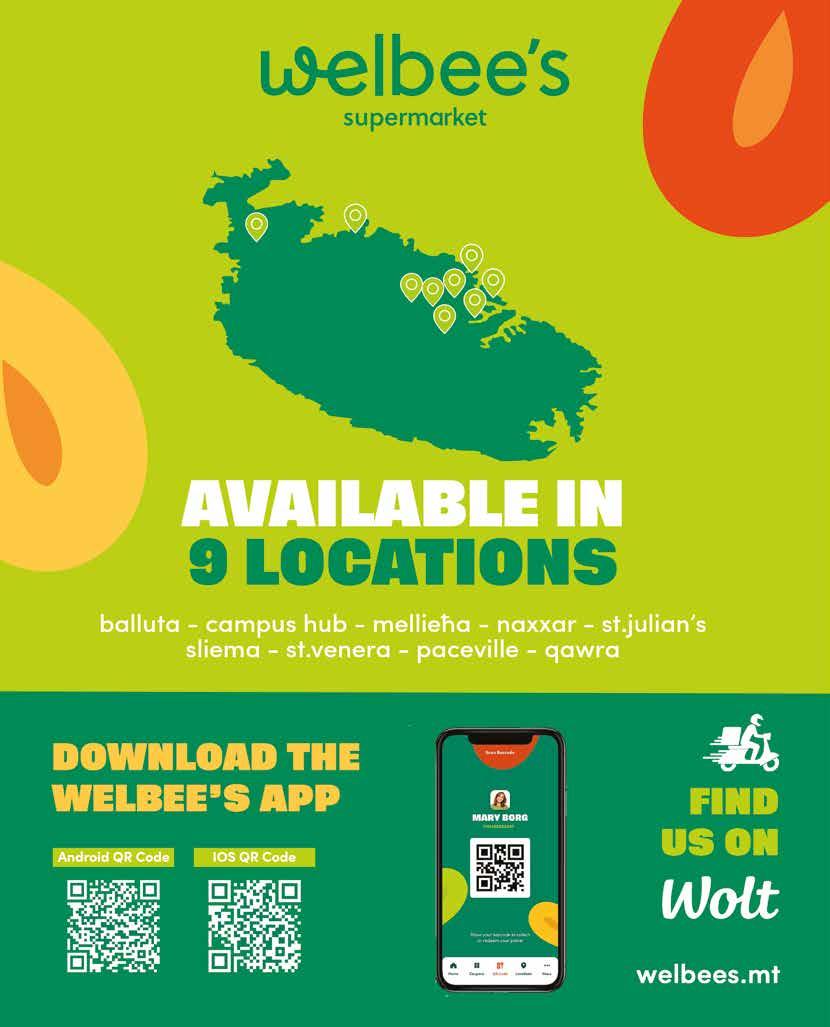
HERALDING IN THE SEASON OF THE LAMPUKA
The lampuka, the Maltese name for the popular dolphin fish, (also known as dorado or mahi-mahi), has been a staple on local tables for generations at this time of year, representing a long tradition deeply associated with Malta’s small-scale fishing sector. SARAH MUSCAT AZZOPARDI finds out about this celebrated local fish, and how best to enjoy it on your visit.
The fishing season for lampuki is from 15th August through to the end of December, but the peak of its popularity is in August and September, fitting beautifully, as it does, within local summer and autumn cuisine.

For the fishermen, the season kicks off a few days before 15th August, when the c130 vessels which
are licensed to fish for lampuki set off together at midnight, mostly from the fishing village of Marsaxlokk in Malta and Mġarr in Gozo, to cast their kannizzati (more on this soon). In a wonderful tradition that belies Malta’s religious roots, the whole operation is preceded by a Holy Mass on the waterfront by the local parish priest, who then boards a small kajjik and sails out to bless the luzzijiet (the traditional, colourful fishing vessels) and their crew.
051
FOOD & DRINK
viewingmalta.com
Photo: Clive Vella
-
The technique used for fishing for lampuki is a unique one that’s also steeped in tradition, having remained practically unchanged for centuries. The fishermen start by casting Fish Aggregating Devices (FADs), known as kannizzati in Maltese, which are made up of a polystyrene float anchored by a heavy piece of limestone. Palm fronds are then attached to the float to attract the fish.
The fish tend to seek shelter, which is where the palm fronds come in, luring whole shoals towards the kannizzati. The fishermen cast their nets once enough fish have gathered, and there you go –lampuki for dinner!
Having spent the entire year working on their FADs, the fishermen cut the palm fronds and tie them to the kannizzati one week before the launch of the season. It is then that the waiting game begins. Rough seas tend to disturb the shoals, so the fishermen need calm weather to catch lampuki And while the season officially lasts till the end of the year depending on weather conditions, it can be extended by a special derogation for one month, in case of bad weather.
Of all the fish that finds its way into our cuisine on the Maltese islands, lampuki have undeniably remained an enduring favourite over the years, and local consumers look forward to the season just


FOOD & DRINK
052
The traditional, and often preferred, method of cooking for most locals is fried simply and served with a caper and tomato sauce.
Photo: Elaine Stocks - Instagram
Marsaxlokk Harbour. Photo: Gregory Iron - viewingmalta.com
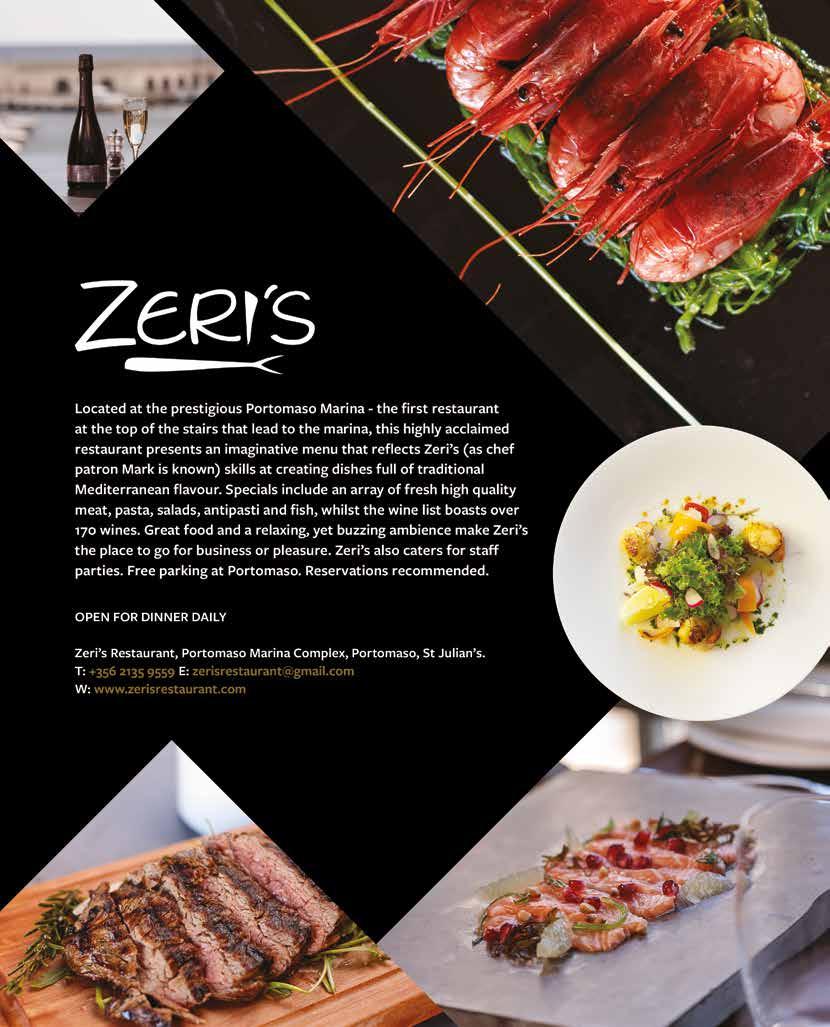

as much, if not more, than the fishermen themselves. Maltese lampuki, in fact, are not exported due to the high demand locally, and can be prepared in a variety of ways to showcase their delicious flavour.
The traditional, and often preferred, method of cooking for most locals is fried simply and served with a caper and tomato sauce. Another local way of preparing the popular fish is in a hearty pie encased in a flaky, buttery shortcrust pastry. While various recipes exist for the much-revered lampuki pie, each local you meet will likely claim their family recipe to be best, but regardless of whether their preferred filling favours spinach or raisins as the secret ingredient, the outcome is generally very similar: a delicious dish showcasing the best of the lampuka

Still, the fish remains incredibly versatile, and apart from these methods, you’re equally likely to find it on local menus used in a variety of typical and atypical ways. Think pizza topping, in canapés, as an appetiser or simply baked, grilled, barbecued, cured and of course, within a hearty aljotta – a
traditional mixed fish soup – the definition of late Maltese summer on a plate.
If you’re visiting at this time of year, you will certainly spot fresh lampuki on the majority of local restaurant menus, but some of the best to be had will undoubtedly be within the eateries dotted along the coast of the fishing village of Marsaxlokk. And it’s hardly surprising, with the fish going directly from the fishermen’s boats to the kitchens across the road before landing on your plate. It can’t get fresher than that, can it?
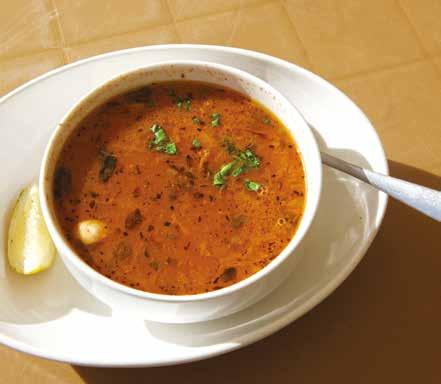
055 FOOD & DRINK
The technique used for fishing for lampuki is a unique one that’s also steeped in tradition, having remained practically unchanged for centuries.
Lampuki pie. Photo: Therese Debono
Aljotta. Photo: Renata Apanaviciene -Shutterstock

WASTE SEPARATION IN MALTA IS EASY: HERE IS WHAT YOU NEED TO KNOW
Malta has recently taken a commendable step towards sustainability by introducing new regulations on waste management. The Environment and Resources Authority (ERA) is leading this initiative of making waste separation mandatory for all – from businesses and households to governmental and non-governmental entities. These regulations were adopted on 14th April 2023 following a nation-wide public consultation held last year. ERA aims to address the public’s environmental concerns through a mandatory approach to waste separation, and fines can be imposed for non-compliance.
All residents in Malta are now obliged to separate their waste into organic, recyclables, glass and general waste, and are to adhere to the national waste collection schedule. To embrace waste separation effectively, it is essential to understand the categories and guidelines for proper waste separation, which is, in itself, very straightforward. Waste is collected from door to door every day, except on Sundays. Organic waste is collected on Mondays, Wednesdays and Fridays; general/mixed waste is collected on Tuesdays and Saturdays; whilst recyclables are collected on Thursdays. Glass is collected in a sturdy, reusable container every first and third Friday of the month or you can make use of the Bring-In Sites or iBins.
It is only through such small efforts and everyone’s cooperation on the proper separation of waste that Malta can have an effective recycling system and can prevent significant amounts of mixed waste from being dumped in landfills. Currently, 90 per cent of Malta’s municipal waste ends up in landfills; the target is for this figure to be reduced to a mere 10 per cent by 2035, however, this is only possible if we all join forces.
Through this regulated approach to waste, Malta can also improve cleanliness in its villages and towns, and discourage the irregular dumping of waste bags in public areas. This is crucial in a small island where land area is limited and that is chosen as a holiday destination by millions of tourists.
So, whether you are enjoying Malta for just a few days, for a longer period or you are a resident, ERA encourages you to adhere to these regulations and make proper waste separation part of your daily routine. Separation is easy –dispose of your waste in the appropriate bag!
For more information, visit wastecollection.mt

057 ENVIRONMENT
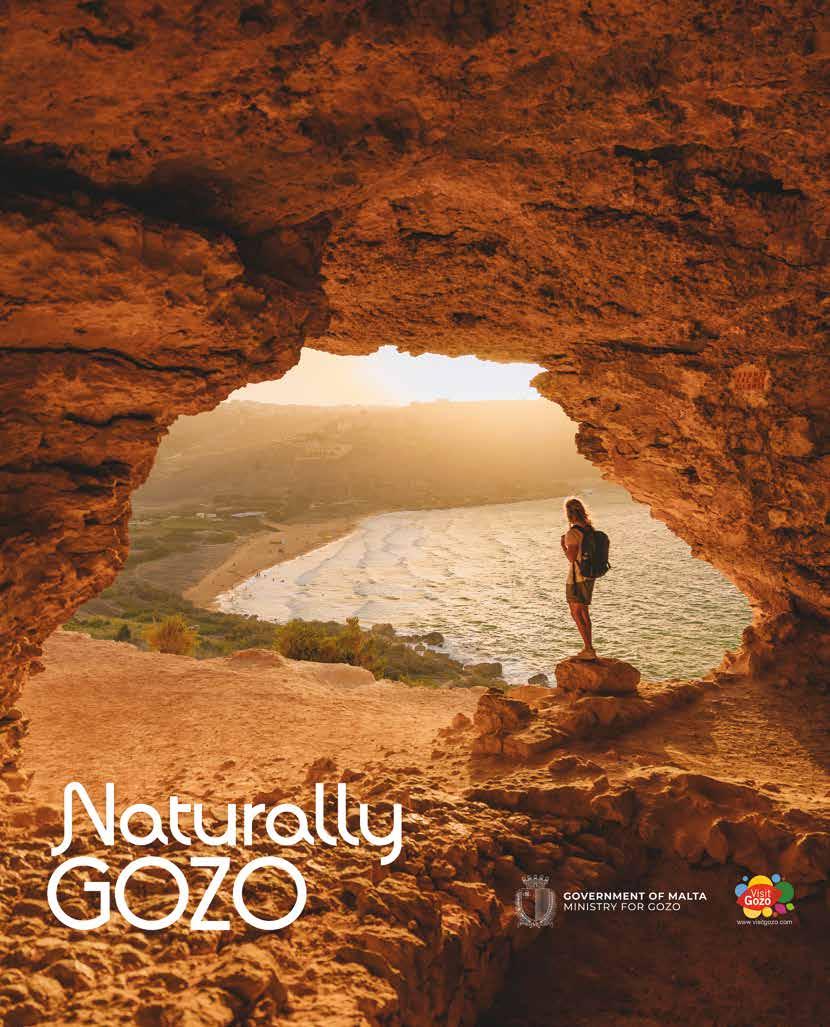
MALTA – A BUSINESS AND FINANCIAL SERVICES HUB IN EUROPE
Since Malta joined the European Union almost 20 years ago, and later adopted the euro, the islands have been punching above their weight when it comes to attracting foreign investment to their shores.
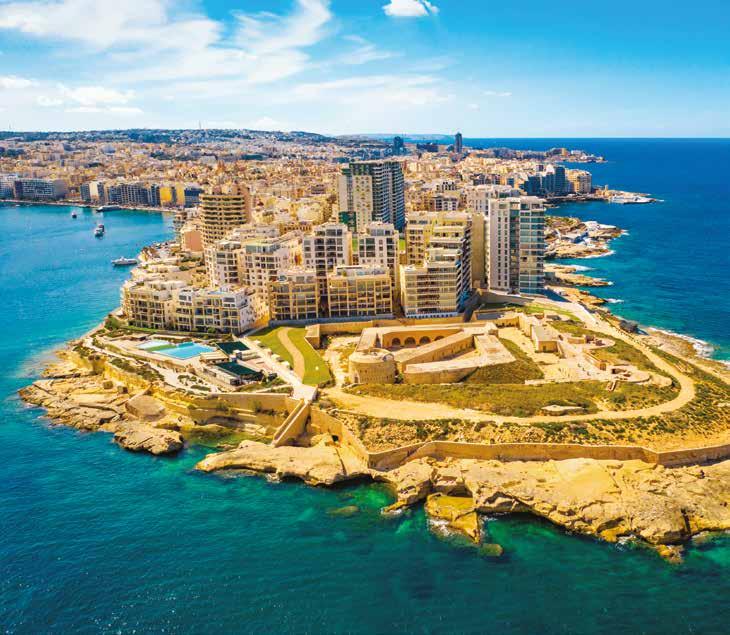
The country has evolved into a trans-continental hub for trade, a popular tourism destination and a top performer in high-tech industries such as high value-added manufacturing, aviation maintenance, financial services, iGaming, cryptocurrency,
shipping, and emerging technologies, including Artificial Intelligence. This high-paced activity has attracted an influx of expats, who contribute to render the social and economic landscape truly exciting, diverse and cosmopolitan – could you be the next to join?
Whether you’re searching for a fresh start in life, or simply looking to grow your business, Malta could be the steppingstone you’ve been waiting for. But before you make the move, here are some things you need to know.
059
INVESTING IN MALTA GUIDE
Sliema.
Photo: Karina MovsesyaniStock
ALL ABOUT SETTING UP A BUSINESS IN MALTA
With a well-established regulatory environment based on EU law, a favourable tax regime, attractive Government incentives and a well-educated and highly motivated workforce, Malta can be a very attractive place for a foreigner to set up a business. Doing business in Malta does not only mean access to trade in the EU, but also gaining access to Africa and the Middle East, as Malta has developed healthy business ties and beneficial fiscal agreements with various countries in these two regions too. For those who wish to start a business in Malta, there are seven stages to keep in mind:
OBTAINING LICENCES AND A TAX IDENTIFICATION NUMBER
1. DECIDING BETWEEN SELF-EMPLOYMENT AND SETTING UP A LIMITED LIABILITY COMPANY
A limited liability company gives your business a more trusted face and protects you as a shareholder in case of defective products or lawsuits. On the other hand, there are more bureaucratic steps to follow when creating such a company (as opposed to starting a business as a self-employed person), such as undergoing an annual audit, so make sure your business is viable before registering it as LTD. You need to be at least two shareholders to register a company.
PREPARING FOR REGISTRATION
5. 6. 7.
If you are going to proceed with a limited liability company, then you need to draft the company’s memorandum and articles of association. These documents are important for registration, but they also detail what the company, its shareholders and its directors can and cannot do. It is important to identify the right legal firm, accountancy and audit firms, as well as business consultants to guide you during this stage.
GETTING A VAT NUMBER AND PE NUMBER
You also need to register with the VAT Department to obtain a VAT number. Furthermore, if you have a limited liability company and you intend on hiring personnel, you also need to register as an employer and obtain a PE number. Both steps are free of charge and can be carried out online.
REGISTERING WITH JOBSPLUS
Once the trade name is approved and the memorandum and articles of association are filed with the Malta Business Registry, the company is almost ready to start operating. However, before that, one must also check if any special licences are required. Furthermore, each business in Malta must have a tax identification number. While this is free of charge to obtain, once a year you will need to fill in a tax return form. This is another step where the assistance of a trusted accountant, audit or legal firm is invaluable. 2. 3.
Jobsplus is responsible for all employment registration in Malta. You need to fill in a form for each employee upon registration, and again upon termination of each employee. The process is quick and free of charge.
DEPOSITING THE MINIMUM SHARE CAPITAL
Every company needs some capital to start off, however small. As a new business owner, you need to open a bank account in the company’s name and inform the bank that you are depositing your share capital. The money will go into a holding account until the company is properly registered. The receipt issued will need to be presented in the next stage.
Government department Business First can help you with all of these steps, and can be easily reached through their website, www. businessfirst.com.mt, or over email. 4.
PRESENTING DOCUMENTATION TO THE MALTA BUSINESS REGISTRY
The filled-in company registration form, together with the memorandum and articles of association and the share capital deposit slip need to be presented to the Malta Business Registry. Registration is done within two to three days and the registration fee depends on the size of the company.
ABOUT MALTA Population 519,562 According to the latest figures published by the National Statistics Office Area 316 km2 Currency Euro Forecast GDP Growth 4 per cent in 2023 Compared to 2022, according to the Central Bank of Malta Unemployment Rate 2.9 per cent As at March 2023, according to the National Statistics Office INVESTING IN MALTA GUIDE 060
FINDING THE RIGHT PROPERTY
Once you’ve decided to move to Malta, you’ll set about finding the perfect property for you and your family, or the new headquarters for your business. But what will that involve?
• The cost of living in Malta remains lower than most European countries, but rent has become more expensive in recent years. You can expect to pay at least €1,000 for a flat in a central part of the island, and far more if it’s in one of the more in-demand locations such as Sliema or St Julian’s. Office or commercial spaces have seen less of a spike in prices, but as with homes, are largely dependent on location.
• Most people start their search through a property agency, of which there are countless ones on the island. Some specialise in commercial properties, others in residential. It’s worth noting that many properties are listed with several estate agents, so you may end up viewing the same property several times if you’re not careful.
• Once you’ve viewed a few different properties, settled on one that you want to buy, and your offer has been accepted, you will be asked to sign a promise of sale, known in Maltese as a konvenju. This is a legally binding agreement between you and the seller, and will involve a notary public.
• At this point you are obliged to pay 1 per cent of the 5 per cent provisional stamp duty. The total sum is payable upon completion of the sale. You will also need to pay a deposit which is usually around 10 per cent of the agreed sale price.
• You don’t need a permit to buy a house here unless it’s a secondary residence. But if you are not a citizen of an EU country, then you will need an Acquisition of Immovable Property in Malta by Non-Residents Permit (AIP).
• You must also obtain a permit if you are considering renting your property as a holiday home, and any earnings must be declared to the authorities for tax purposes.

061
INVESTING IN MALTA GUIDE
Birgu.
Photo: Radiokukka - iStock
SPOTLIGHT ON EMERGING ECONOMIC SECTORS
In recent years, Malta has positioned itself as a prime destination for several tech companies looking for a secure, reliable and reputable jurisdiction to base themselves, drawing companies from a wide spectrum of digital and innovative sectors, ranging from blockchain to FinTech to Artificial Intelligence.
Speaking of blockchain, Malta was dubbed as the ‘Blockchain Island’ in 2018, being the first country in the world to issue a comprehensive set of regulations and guidelines on blockchain, Initial Coin Offerings, technology arrangements and financial assets. Today, it is reaping the results of this proactive stance through the establishment of a number of FinTech and crypto companies on the island, while also widening its scope to attract companies that operate in all corners of the digital space.
Three bills were passed into law in 2018 which set up the Malta Digital Innovation Authority (MDIA) Act, the Innovative Technology Arrangements and Services Act (ITASA) and the Virtual Financial Asset (VFA) Act.
The MDIA acts as a communicator between key national bodies such as the Malta Financial Services Authority (MFSA), other relevant Government regulators such as the Malta Gaming Authority (MGA) and operators. It also regulates new and emerging technologies. The ITASA is geared towards regulating technology service providers, while the VFA Act regulates Virtual Financial Assets. Such laws limit the scope for fraudulent activity, provide certainty to investors and also provide a legitimate legal framework in which operators can do business.
Another economic niche creating significant buzz on the islands is Artificial Intelligence, backed by Government’s vision to put Malta on the map with

a National Strategy for AI. This includes discussions on the subject with stakeholders to identify policy, regulatory and fiscal measures aimed at strengthening Malta’s appeal as a hub for foreign investment in this sector.
To date, the MDIA has certified three Systems Auditors (SA), the roles of whom are to audit the Innovative Technology Arrangements that an applicant proposes, including those concerning Artificial Intelligence.
Meanwhile, local businesses are starting to make use of AI to trim costs, such as having a chatbot as the first point of contact for customer queries. If you’ve got a healthy risk appetite, investing in AI in Malta in these early stages could ultimately yield excellent results, before competition begins to grow. If you
062
INVESTING IN MALTA
GUIDE
Grand Harbour. Photo: viewingmalta.com
would like to get a better feel for the industry and the network of people within it, keep an eye out for conferences and events on AI that typically take place in Malta between September and November.


A regulatory push for all-things digital makes Esports another niche area with interesting investment options. The number of skilled software developers, graphic designers and IT proficient workers makes Malta an attractive option for investors. And with an exciting enough project, it should not be difficult to find skilled workers to fill the roles.
With the global Esports industry projected to reach a global audience of 64.8 million people by 2025, according to Statista, a global provider of
market and consumer data, it’s no surprise that Malta has opened its doors to Esports companies just as it did with gaming. While still a budding industry locally, Government’s commitment through ‘Malta’s Vision for Video Games Development and Esports’, launched in May 2019, will help propel this sector forward, with plans to grow it from 0.1 per cent to 1 per cent of the islands’ GDP in 10 years.
Tying all this together is the Maltese Government’s plan and commitment to transform the country’s economy into a digital one in the coming years, enhancing ICT policy development and implementation that is intended to meet the expectations of citizens, civil society and businesses – and its efforts are paying off.
In the EU’s most recent Digital Economy and Society Index (a composite index that summarises relevant indicators on Europe’s digital performance and tracks the evolution of EU member states in digital competitiveness), published in July 2022, Malta maintained its ranking from 2021 and ranked sixth among 27 countries for its digital performance, which includes connectivity, human capital, use of internet, integration of digital technology and digital public services. Placing ahead of Estonia, Luxemburg, Austria, Germany, Belgium, and many others, Malta is well-positioned to achieve its target of becoming a leader in the digital economy, creating a robust foundation for digital sectors to reap fruit.
063
INVESTING IN MALTA GUIDE
Photo: Jeremy BezangerUnsplash
SHOP THESE SUMMER MUST-HAVES AT THE AIRPORT

It’s holiday time, and the only items that should be on your agenda right now are rest, relaxation and recreation. Are you ready to soak up the sun in the Mediterranean? Well, you’re not ready until you’ve checked out our list of summer must-haves which you might need throughout your stay on the Maltese islands, and which may all be purchased at the airport’s retail outlets.
FOR A DAY BY THE BEACH
Shoes? Check. Swimwear? Check. An extra beach towel to lay on and dry off after swimming? You might want to check out Agenda Bookshop’s Dock and Bay microfiber towel collection, which comes in an array of colours and caters for all ages. While you’re at the bookshop, you might also want to check out the latest beach reads to hit the shelves.
Cloudless skies are the norm in the summer on the Maltese islands, so you’re going to need some serious sun protection before your beach day. Stock up on sunblock with high SPF from the airport’s WHSmith outlet or the airport pharmacy. You might also want to invest in a good
064
SHOP
pair of sunglasses from the HEBE outlet on Level 0 to protect your eyes against the sun’s UV rays.

You’re also going to need an insulated cup to stay hydrated in the heat, so check out the stock of thermal cups and bottles at Costa Coffee inside the Check-In Hall to keep your drinks cool on the go. Last but not least, get hold of a comfortable bag to carry your beach essentials around with you. Samsonite’s Securipak backpacks are not only lightweight but are also equipped with a convenient USB port and are made from 100 per cent recycled PET material.
FOR A NIGHT OUT
Between the weekly village feasts, the sporadic wine, beer and food festivals, and the vast array of parties which are organised on a regular basis on the islands, the vibrant nightlife in Malta and Gozo is definitely something to look forward to.
As with any other events, you’re going to want to look and feel your best. Pair your fresh tan with a naturally cool, fresh-faced make-up look and a couple of spritzes of a fragrance that smells just like summer. Head to WHSmith on Level 0, and you’ll be spoiled for choice on both fronts.
Speaking of looking your best, we can’t leave out the arm candy, can we? From dainty bracelet collections for women to a fantastic range of watches for men, there really is something for everyone at HEBE. Complete the look by splashing out on a new leather wallet or a chic handbag from Samsonite.
FOR A COMFORTABLE SIGHTSEEING EXPERIENCE
Despite their relatively small size, there’s a lot to see and do on the Maltese islands, so you’ll probably be moving around a fair bit throughout your stay here. In this case, we’d recommend travelling light and only carrying the essentials around with you.
As the weather can be hot and humid during the day, wear breathable, lightweight clothing and a good pair of shoes that will help you stay comfortable. Speaking about comfort, consider investing in a good bum bag from Samsonite which is not only a more compact and secure alternative to a backpack or handbag, but will also allow you to keep your hands free, which could be especially useful when exploring a new place.
At Agenda Bookshop inside the Check-In Hall, you’ll also find some smaller items which might enhance your sightseeing experience, including power banks, insulated water bottles that you can refill throughout the day, as well as guidebooks to help you find your way around the country.
TO TAKE BACK HOME WITH YOU
So, your holiday has come to its inevitable end, but you’ve got a tonne of memories (and some truly unique souvenirs) to take back home with you. Ditch the usual airport chocolates and treat yourself to something a bit more high-end this time around. Sunday in Scotland’s artisanal chocolate falcon is definitely something you won’t find anywhere else, but you could also opt for smaller yet equally delicious treats, including delectable nut spreads, intricate chocolate boxes and a variety of fresh cakes and cookies.
You’ll also be able to find souvenirs with a more local feel at Departures. In fact, there’s an entire Spirit of Malta section inside the airport’s Dufry outlet which stocks everything from Maltese sea salt to the locally hand-crafted Nemnem candles.
If you’d like to splurge on something you can wear, you might want to check out the jewellery collections inspired by Maltese heritage at HEBE or rock an exclusive Malta top from Hard Rock Café. … And we didn’t even mention the best part. If you’re travelling to a non-Schengen country, anything you purchase after the security checks will be tax-free!
065
WHEN ARCHITECTURE AND FASHION COLLIDE

In fashion, as with many creative disciplines, incredible things often come about as a result of collaboration. Such was the case in a recent project by Malta’s Planning Authority (PA) and local design duo SAMARIA and VINCIENNE BEZZINA behind Maltese fashion brand BAJJA – a project that has redefined the relationship between fashion and architecture. SARAH MUSCAT AZZOPARDI learns more.
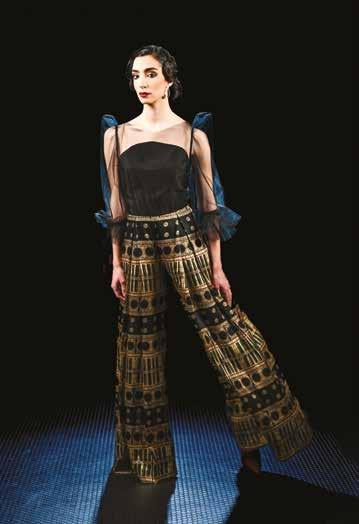
FASHION
066
Balluta Buildings
Tarxien Temples
Speaking about the process behind their recent collaboration with Malta’s Planning Authority, BAJJA designers Samaria and Vincienne Bezzina explain how they were first approached by the PA following their brand’s debut at Malta Fashion Week last year, where they launched their first swimwear collection inspired by the wonders of Gozo’s Ramla l-Ħamra bay and its surrounding landscape.
“We were approached to collaborate on a project that explores the intersection between architecture and fashion, to be featured as part of the Malta Architecture and Spatial Planning (MASP) Awards,” they explain, and after doing some groundwork and exploring the captivating link between both disciplines further, they decided to take it on.
“Similar to architecture, fashion design is based on


form, idea and expression as means of non-verbal communication and builds on concepts of scale and proportion, detail, balance, ornamentation, light and shadow, solid and void, linearity, transparency, texture, colour, rhythm and space,” the designers explain – and both being warranted architects, they certainly know what they’re talking about!
Speaking of their architecture background, Samaria and Vincienne reveal, “as two siblings and architects coming from an artistic background, we have always found means to explore our creativity in other artistic fields, such as fashion design. The project entrusted to us by the Planning Authority was a perfect opportunity to bridge both practices of architecture and fashion, and push our boundaries in design by experimenting with structural silhouettes, geometric patterns and
067
Fgura Parish Church
Dar il-Ħanin Samaritan

unconventional materials to create ‘wearable works of art’ that is a staple for our fashion brand.”
This interesting parallel between fashion and architecture led them to draw inspiration from local buildings that have distinct forms, styles and functionality, giving them their own interpretation through the art of fashion. The resulting project took inspiration from the features, philosophy and design of four local landmark buildings: Balluta Buildings, Dar il-Ħanin Samaritan, Tarxien Temples and the Fgura Parish Church.
Speaking about what it is about these buildings that stood out for the collection, the designer siblings explain that with the main purpose behind the MASP Awards being to give recognition to outstanding contributions to Malta’s local architecture scene, it made sense to draw inspiration from four local architectural buildings that are reflective of design excellence and high-quality craftsmanship in their respective eras.
“The process that led to the choice of buildings was an important and rather profound part of the creative process, as we took time to understand the physical and emotional response that different architectural settings evoke. This exercise ultimately led to four buildings or spaces which offer unique attributes that immediately sparked our inspiration through their
BAJJA’S TOP FASHION TRENDS TO LOOK OUT FOR THIS SUMMER

This season, it’s all about pastel colours, flowy silhouettes and sustainable fashion.
“Pastel shades evoke a sense of softness and freshness, while adding a touch of femininity and elegance to your summer wardrobe. Flowy silhouettes, such as maxi dresses, palazzo pants and oversized shirts, also offer a breezy and effortless look during the summer season, while sustainable fashion is also becoming increasingly popular with designs that are convertible or reversible offering versatility and adaptability. This aligns with the principles of our fashion brand where we strive to maintain the highest standards of sustainability by designing pieces that boast versatility in styling through reversible and multi-way concepts.”
distinctive forms, elements, motifs, materials, functionality or philosophy,” they reveal.
Following a deeper understanding of each building, they could experiment with sketching, reinterpretation of details, mood board creations, draping and digital prints, to explore various possibilities that balance the interplay between the architectural inspiration and the wearability of the designs. All of this, of course, while maintaining the essence of the original architectural concept and keeping the quality of construction, precision in detailing, and use of high-quality materials as top priority.
The first garment was inspired by Balluta Buildings, which were designed in an Art Nouveau style by architect Giuseppe Psaila. Here, prominent features including the building’s three prominent arches, wrought iron gate and green shutters went on to inspire the structure and print of the resulting dress.
Meanwhile, the garment inspired by Dar il-Ħanin Samaritan was designed to incorporate the overarching concept and experience of walking through the space – an area of solace and prayer which reflects the journey through life, from birth to life beyond death.
The third piece in the collection was inspired by Fgura’s parish church, Our Lady of Mount Carmel, which the designers describe as one of the most original structures to be built in reinforced concrete on the island. Here, aspects like the church’s multifaceted exterior featuring solid inclined triangles and stained-glass panels, the simplicity and elegance of its structure, and its pyramidal roof are all
069 FASHION
reflected in the garment through its design and use of fabrics.
The final garment, inspired by Tarxien Temples, features a printed silk cotton shirt which incorporates the detail of stone carvings which the megalithic monuments are renowned for, as well as an embroidered detail of the structures’ oculus motif, while the beige material chosen for the bodice and skirt gives an impression of animal skin, paying tribute to the importance of animals in prehistoric societies. The use of pleats mirroring a pleated skirt worn by a deity in the South Temple and the horizontality of the bodice together with the vertical bottom parts of the shirt, reflecting the Trilithon entrances, further celebrate the essence of these unique architectural masterpieces.



Ending our discussion with their thoughts on Malta’s fashion scene and how it has developed in recent years, the BAJJA designers highlight a growing interest in fashion, with local designers, models and fashion events gaining more recognition, both locally and internationally. “Local fashion weeks, such as the Malta Fashion Week and
Fashion Awards, have become significant platforms for designers to showcase their collections and for fashion enthusiasts to explore the latest trends. Such events also attract international designers and industry professionals, fostering networking opportunities and collaboration within the fashion community,” they say.
Meanwhile, the rise of social media and online platforms has also had a significant impact on the fashion scene in Malta, as it has globally. In Samaria and Vincienne’s views, it has provided a platform for local designers, models and fashion influencers to reach a wider audience and promote their work. Online retail has also become more prevalent, allowing fashion enthusiasts to access a broader range of brands and styles.

The process that led to the choice of buildings was an important and rather profound part of the creative process.
Ballutta Buildings.
Photo: Agata GrzeszczakUnsplash
Tarxien Temples.
Photo: Heritage Malta
070

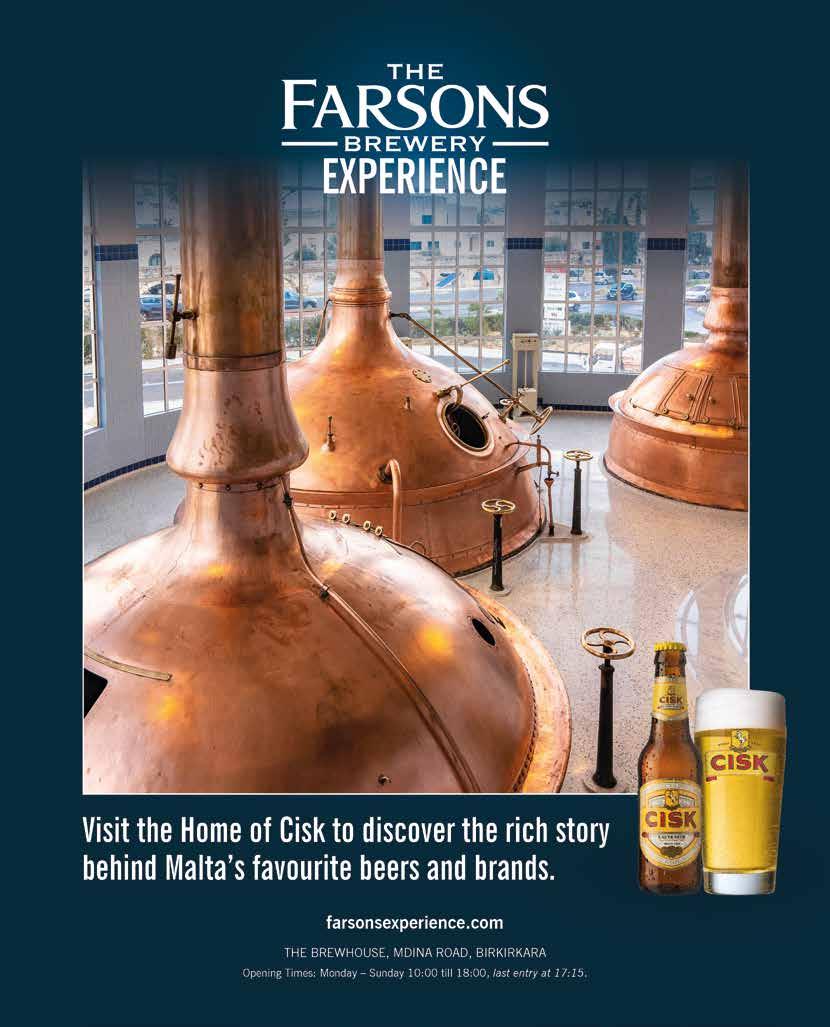
THIS SEASON’S TOP PICKS FASHION FOR HER
FENDI
Medium Baguette Bag
Iconic medium Baguette bag, made of camellia Cuoio Romano leather embellished by hand with matchingtone stitching. Decorated with an FF clasp. The bag can be carried by hand or worn either on the shoulder or cross-body thanks to the handle and shoulder strap, both detachable.

DOLCE & GABBANA
Maiolica-Print Pencil Skirt

This midi skirt is printed with the Maiolica pattern, a Dolce & Gabbana signature pattern inspired by traditional Sicilian pottery designs. The pencil silhouette sits high on the waist and falls to a mid-length.
BOSS
Slim-Fit Suit In A Linen Blend
An elegant two-piece suit with silk-blend trims by BOSS Menswear. Ideal for evening events and other special occasions, this distinctive suit is crafted in a linen blend containing stretch for comfort in movement. This ensemble is offered in a streamlined fit and lined with signature material.

FOR HIM
BALMAIN
Black Knit Sheath Dress

Sheath dress by Balmain in black viscose knit, featuring cut-out detail on the chest, mesh panels, gold-tone buttons, and turtleneck collar.
MISSONI Multicoloured 3D-effect Viscose Bikini


The Resort 2023 Collection embodies the femininity and the sensuality of a woman with a refined soul. The inspiration of this aesthetic goes back to the ‘90s and the ‘00s, and represents its minimal spirit.
DOLCE & GABBANA
V-Neck T-Shirt
Logo cotton V-neck t-shirt from Dolce & Gabbana featuring white, cotton, silver-tone logo plaque, V-neck, short sleeves and straight hem.

ZEGNA
Off-White Deerskin Triple Stitch™ Low Top Sneakers

BOSS
Recycled-Material Swim Shorts with Monogram Print

Modern swim shorts with full lining by BOSS. Featuring a hardware logo trim at the waistband, these swim shorts are printed all over with the BOSS monogram.
Crafted from off-white deerskin, the Triple Stitch™ low top sneakers are a sophisticated take on casual footwear. The iconic, triple-crossed elastics evoke the hand-stitching of classic leather shoes. Perfect for fast-paced lifestyles, the lightweight design slips on effortlessly.
SARTO, Ross Street, St Julian’s, T: 2202 1601
073
MALTA UNVEILED: UNMISSABLE EXPERIENCES ON THE ISLANDS
Curate your cultural calendar over the next few months with the most vibrant feasts and music events, and thought-provoking art shows. To help you do so, REBECCA ANASTASI speaks to some of Malta’s veritable cultural experts – cultural advisor TONI ATTARD; painter ALEXIA COPPINI; actress CHARLOTTE GRECH; and filmmaker CHARLIE CAUCHI – who each give their insight on what to experience this season.

074 ART & CULTURE
Photo: viewingmalta.com
Summertime always brings with it a heady sense of the unexpected, of discovery in the quietest of places or thrills in the cacophony of crowds. In Malta, it announces its arrival with the smell of orange blossom in the air – known in Maltese as żahar (pronounced za’ar) –bringing with it lazy afternoons, soft sunsets and long evenings with family and friends. The Mediterranean islands also bustle with a smorgasbord of events, cultural outings and traditional activities, making the months from August to October the season when anything can happen, though the calendar of events is admittedly rich throughout the year.
“I associate August with the village festa,” Toni Attard – a well-known name on Malta’s art scene – says, adding that this is perhaps the most “dominant religious, communityled, cultural expression over summer,” characterised by vibrant fireworks and a flurry of good spirit. The 15th of the month sees the country celebrate the Feast of the Assumption of Our Lady. This is “also known locally as Santa Marija, and the feast is celebrated across seven different villages in Malta and Gozo. Just show up in any of the villages on the evening of 14th August and soak up the sights and sounds,” Toni says, pointing to his hometown of Mqabba as a special place, “known for its spectacular fireworks displays that are best enjoyed from the main street in front of the open fields.”
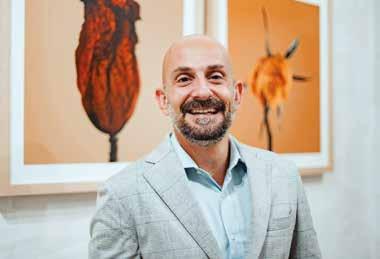

Moreover, the hot months bring with them celebrations of music, art and theatre, and have become known as the festival season. “I love everything about them – the art, the venues, the people, the connections,” he says, citing the example of the Mediterranean Literature Festival, organised between 21st and 27th August, which, he says, “is a great festival bringing together award-winning authors and their works.”
This summer, Toni is also the artistic director of EuroPride, taking place between 7th and 17th September. This is expected to be a “jam-packed week of arts events in the wider pride programme presenting unique works from across the region in multiple genres and styles. From contemporary art to classical music, from burlesque to drag, from films to circus, we’ve got a great line-up of diverse queer voices and creative expression,” he says. The actual march, taking place on 16th September, will also feature Cristina Aguilera, live in concert.
075
Don’t use a map, just look up and get lost in the city’s architecture and layers of history. For Baroque lovers, don’t miss a visit to Teatru Manoel, Casa Rocca Piccola and the St John’s Co-Cathedral.
TONI ATTARD, CULTURAL ADVISOR
Casa Rocca Piccola
Photo: Lindsay Bahia

Apart from these high-calibre events, Toni also points to other must-sees on the island, with Valletta coming top of his list. “I always recommend two to three full days to pack in as many cultural experiences as possible. If you stay in the capital, it’s even better. Don’t use a map, just look up and get lost in the city’s architecture and layers of history. For Baroque lovers, don’t miss a visit to Teatru Manoel, Casa Rocca Piccola and St John’s Co-Cathedral.”
He also has a few tips! “To avoid the crowds at the CoCathedral and to enjoy a more artistic experience, check out Valletta Resounds – the Caravaggio Experience – which combines storytelling with classical music in front of the Caravaggio masterpiece ‘The Beheading of St John the Baptist’. These will restart in September and tend to sell out in advance. Valletta also hosts the night-long Notte Bianca on 7th October, with the whole city transformed into one large-scale arts city as museums, churches, theatres, and squares host all kinds of cultural events.”
Off the beaten track, and away from the capital, Toni recommends visiting the village of Mqabba and new contemporary art gallery, Il-Kamra ta’ Fuq at New Life Bar, which boasts “the most eclectic programme of Malta’s most prominent artists. The visit cannot be complete without eating a ftira (now listed as UNESCO intangible world heritage) from the bar,” he insists, referring to the traditional Maltese snack consisting of a small loaf stuffed with tuna, pickles, onions, capers, and tomato paste.
Painter Alexia Coppini also refers to Il-Kamra ta’ Fuq as one of the most exciting arts venues the island currently has to
offer. However, it is not the only one, she insists. “There are so many contemporary art exhibitions and new galleries sprouting all over the island. For instance, there’s Christine X in Sliema and Gallery 23 in Balzan,” she explains. Indeed, Christine X is currently exhibiting the works of Olaug Vethal, a Norwegian artist who had worked internationally but had made Malta her home. Vethal’s bright and bold works evoke a sensuous luminosity of life by the sea. Meanwhile, Gallery 23 in Balzan is showcasing a spate of local artists, such as Marisa Attard, Henry Falzon and Julia Borg. One of Alexia’s favourite artists at the moment is the sculptor Andrew Diacono. “I collect his work and he is brilliant,” she says.
“I would also recommend the exhibitions at the Phoenicia Hotel in Floriana,” Alexia continues, referring to the Art Deco, five-star hotel on the outskirts of the capital, Valletta, which first opened in the 1930s. “They always exhibit in their Palm Court; the hotel itself is a historical landmark so a stop there would always be top of my list, if I were in Malta for just a few days.” Alexia was, actually, the first artist to exhibit at the hotel, which, due to its long-standing cultural significance has become somewhat of an institution on the island. “That was in 2018, and it was a fantastic experience. I had a cocktail party with 500 people, and I had sold around 40 paintings. I specialise in marine art so the sea forms my imagination; many people can relate to this, and I’ve also had a great response since,” she explains.
In November, Alexia plans to exhibit her work again at the Phoenicia Hotel, showcasing another 40 paintings, which have yet to be completed but which have been produced in memory of her mother who, sadly, passed away just a few


077
There are so many contemporary art exhibitions and new galleries sprouting all over the island. For instance, there’s Christine X in Sliema and Gallery 23 in Balzan.
ART & CULTURE
ALEXIA COPPINI, PAINTER
weeks ago. “My inspiration is her passing, and I’ve already placed some images of my forthcoming work on social media, receiving a phenomenal response.”
When she’s not working, Alexia is enthused by the islands’ treasures. “In Valletta, I head to St John’s Co-Cathedral; a big event was held at the Co-Cathedral a few weeks ago to celebrate the return of the wonderful tapestries following their meticulous restoration,” she recalls.
Apart from the sea, the painter is also motivated by the beauty of the scenery on the island. “I quite enjoy an early morning walk in the Rabat, Tal-Virtu and Mdina areas, as well as in my hometown, Sliema,” she asserts. “I am inspired by trees and nature, and feel it’s important to run away with your thoughts in places and moments where there is no traffic or loud noises. I need a solo existence for my sanity,” she laughs.
Actress Charlotte Grech also attempts to steer away from crowds, so she seeks out music venues showcasing the best talent – but in more intimate settings. “In this heat, it is great to listen to music in an outdoor atmosphere,” she says.

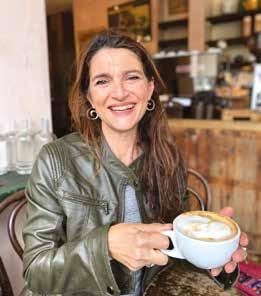
Charlotte’s tastes point to a discerning attitude towards jazz music in particular. Following the Malta Jazz Festival, which took place in July, she intends to enjoy the music at Offbeat, situated in Merchants Street, in the capital. The small venue specialises in jazz, and, indeed, every Thursday, Offbeat hosts artists playing their latest sets – a series of evenings known as Jeudi Jazz. Charlotte also enjoys spending evenings at Il-Gazin, within the Vilhena Band Club, located under the arches on St Anne’s Street in Floriana. This spectacular setting hosts musicians entertaining an intimate crowd on cooler summer nights.
Charlotte has been busy lately, with her play Is-Siġra f’Nofs tat-Triq, so she feels as if she’s already missed quite a bit of the summer season. However, she’s looking forward to a number of upcoming events, including a Beatles Tribute concert at Pjazza Teatru Rjal in Valletta (25th August); the One Act Play Festival (7th-10th September) organised by the Malta Amateur Dramatic Club (MADC) and taking place at the MADC Clubrooms in Santa Venera; and Aura, a Musical in the Dark (12th-15th September), taking place at Esplora in Kalkara.
Filmmaker and multidisciplinary artist, Charlie Cauchi, whose work encompasses video, sound, text, archive and built environments, encourages visitors to the island to keep an eye out on the stellar names who characterise the cultural landscape.
“Take time to visit The Mill in Birkirkara,” she says. “Run by the Gabriel Caruana Foundation, it is an independent, artist-run space housed in an old windmill built in the 1700s.” The Mill has recently hosted the SPRING Artistic Programme, and there
078
ART & CULTURE
In this heat, it is great to listen to music in an outdoor atmosphere.
CHARLOTTE GRECH, ACTRESS
Notte Bianca. Photo: Jason Borg

are other interactive events in the works, including Walking Uncharted Territory, a social practice art research project open to parents and their children who will be encouraged to walk, explore and create public spaces in Birkirkara.
Moreover, Charlie says, there are other initiatives to look forward to. “Later in the year, Fondazzjoni Patrimonju Malti (Maltese Heritage Foundation), will launch the Victor Pasmore Gallery in Valletta, and a new exhibition entitled In Search of the Line will inaugurate the space. The last FPM exhibition was Music in Malta – From Prehistory to Vinyl. It was held in 2019 and was such a treat, so I can’t wait to see what they do this time around,” she explains. The dates of In Search of the Line have yet to be announced, however.
Then, towards the end of 2023, and also with dates yet to be released, ĠUF by Rebecca Bonaci opens at Spazju Kreattiv. “The exhibition celebrates contemporary motherhood. Bonaci, who has recently become a mother herself, uses her practice to present a very personal perspective, examining motherhood through a cultural-historical, philosophical, psychological, and artistic lens. Furthermore, earlier this year, the Representing Pride workshop was held at Rosa Kwir in Balzan with emerging and early-career visual storytellers from or based in the Mediterranean basin. They used their time in Malta to create new bodies of work around LGBTQIA+ stories. Organised by HOLMA in collaboration with EuroPride Valletta 2023, the new work will be showcased during the EuroPride celebrations this September,” Charlie explains.
Finally, photographer Zvezdan Reljić’s latest solo show JA, JA, JA! is now showing at R Gallery in Sliema. “R Gallery is a relatively new venture but has already made its mark in showcasing contemporary art. Upcoming exhibitions include a solo show by Seb Tanti Burlo. And if you’re wandering around the streets of the capital, Valletta, take a moment to explore the exhibition Outside/In. Graffiti and street art have transformed the walls of an old Strait Street cabaret-style haunt, originally called New York,” Charlie attests.
What underscores all of these artistic endeavours is the talent and dedication of their artists, photographers, performers, directors, and producers, all of whom comprise the Maltese art community. She pays tribute to one such figure; musician and visual artist, Andrew Schembri, whose recent passing away has left the entire community reeling in shock. “It feels inappropriate not to dedicate some space to acknowledging Andrew’s contribution to Malta’s cultural landscape. He was a highly talented, dynamic and passionate individual working across multi-disciplines. He really was a rarity. I was lucky to work with him on the Teatru Malta vehicle Drago in 2022. He brought so much to the table – not just his skills but a cheeky humour that got us through a gruelling schedule. Andrew was luminous in so many ways, and his memory will shine. Take some time to look at his back catalogue of work, including with the band Brikkuni.”


080
ART & CULTURE
Take time to visit The Mill in Birkirkara… it is an independent, artist-run space housed in an old windmill built in the 1700s. CHARLIE
CAUCHI, FILMMAKER AND ARTIST
Mellieħa Bay
Golden Bay Għajn Tuffieħa Ġnejna Bay Skorba Temples Ta’ Ħaġrat Dingli Cliffs L-Armier (Armier Bay) Paradise Bay Ċirkewwa Ferry Il-Ġnejna Il-Prajjet (Anchor Bay) Fomm ir-Riħ 221 222 223 41 42 X1 44 101 109 41,42 101 221,222 ,250 X1,X1A 109,109A 101 101 223,225 101 X1A 250 49 225 238 56 101 44, 56 49 49 101 Vict Domus Romana 109A L-Għadira Il-Baħrija Ħad-Dingli Iċ-Ċirkewwa Il-Mellieħa L-Imġarr MALTA N 0 1 2 3 km This map is to be used for personal/non-commercial Unauthorised reproduction is forbidden. For more information please contact us on publictransport.com.mt MALTA
Valletta (Tritoni Fountain) Valletta Cruise
Malta Internat. Airport Bugibba Marsaxlokk Mellieha Mdina Vittoriosa Mgarr Terminal , Gozo Victoria, Gozo 22915504/5507 22915506 22915508/5513 22915505 22915512 22915511 22915514 22915509 22915516
Photo: Ali Tollervey
Popeye Village
TOURISM AUTHORITY TOURIST INFORMATION CENTRES
Port
082 VALLETTA MAP REPUBLIC STREET STRAIT STREET STRAIT STREET OLD BAKERY STREET OLD MINT STREET WEST STREET MARSAMXETT ST GEORGE STREET ST PATRICK STREET ST ZACHARY STREET ORDNANCE STREET SOUTH STREET MELITA STREET MELITA STREET ST JOHN STREET ST MARK STREET GREATSIEGEROAD GIROLAMO CASSAR STREET NELSONSTREET WINDMILL STREET ST LUCIA STREET OLD THEATRE STREET ARCHBISHOP STREET ST CHRISTOPHER STREET ST CHRISTOPHER STREET ST DOMINIC STREET ST NICHOLAS STREET OLD HOSPITAL STREET NORTH STREET ST FREDERICK STREET FOUNTAIN STREET ST SEBASTIAN STREET ST JOSEPH STREET MERCHANTS STREET ST PAUL STREET QUARRY WHARF MEDITERRANEAN STREET ST URSULA STREET BATTERY STREET OLD WELLS STREET STREET ST BARBARA BASTION © Copyright Content House Group 2023 1 Palazzo Preca Restaurant 2 King Shoe Shop 3 Mediterranean Conference Centre & The Malta Experience 4 St John’s Co-Cathedral 5 Valletta Waterfront 6 The Lascaris War Rooms 7 Saluting Battery 8 Auberge de Castille 9 Spazju Kreattiv 10 Our Lady of Victory Church 11 MUŻA 12 Pjazza Teatru Rjal 13 Parliament Building 14 National Museum of Archaeology 15 Joseph Busuttil 16 St Paul’s Shipwreck Church 17 National Library 18 St Paul’s Pro-Cathedral 19 Teatru Manoel 20 St George’s Square 21 Grandmaster’s Palace & Armoury 22 Is-Suq tal-Belt 23 Fort St Elmo PLACES OF INTEREST 1 2 3 4 Hastings Garden Upper Barrakka Gardens Lower Barrakka Gardens 5 6 7 8 9 10 11 12 13 14 16 17 18 19 20 22 23 21 22 15






















































































































